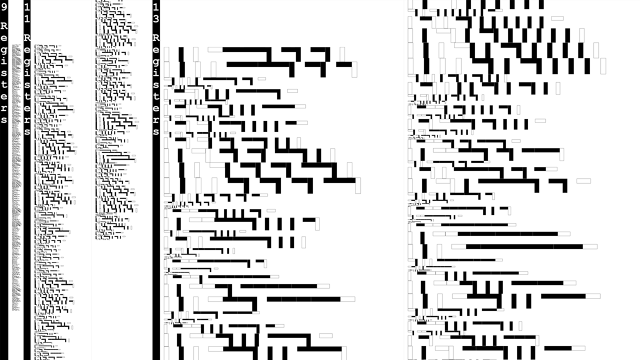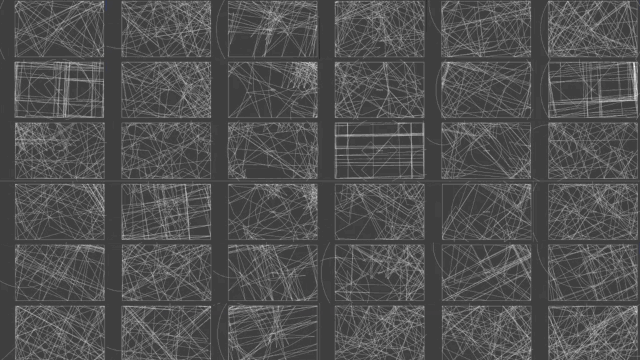Ask a designer or artist if any aspect of their process is random. The answer will likely reveal a complex relationship between human cognition, digital media, authorship, and even conceptions of reality and the divine. For those of us who work in computational media to make art, the question can be even more focused: When and why do you use a “random()” function when you write code?
Randomness is not a new concept. For example, a method for random selection—essentially drawing one lot from many out of a helmet—is explained in Homer’s Iliad. Even in pre-Newtonian 17th-century discourse relating chance, cause, and necessity, a distinction was made between events which appeared to be random—but merely being unpredictable—and events which were truly random. This philosophical inquiry raised metaphysical questions about human agency in the word. Even today, with science settled on the definition of randomness as a non-repeating, non-biased, non-patterned sequence of values, our assumptions about chance, cause, and effect often conflict with the facts.

Rami Hammour
Random occurrences can be easily found in nature. Randomness within the closed system of a digital computer, however, in which all the forces are known and quantifiable, suddenly becomes elusive. For this reason, random number generating functions in computer languages are said to yield “pseudo-random” rather than “true-random” results. Pseudo-random values are generated, by a mathematical series of operations performed to produce a sequence of numbers that repeat with a long enough period to be effectively random, that is, free of pattern or bias. A “seed” serves as the initial value or starting point in the series. Many people are surprised to learn that pseudo-random numbers are entirely determined by the initial seed value and are therefore completely predictable, if you know the algorithm, and repeatable, if you know the seed. Often the default seed value for a pseudo-random number generator is something like the current time converted to a number. This allows even the first few values of the sequence to be different from one run of the program to the next.
The applications of randomness in statistics, computer science, finance, and mathematics are well established, but less so in art and design.
RANDOMNESS CAN SERVE AS WEAK RATIONALE FOR THE ARBITRARY
Imagine a situation in which a design student is asked “why is that shape green?” and the response is “that green color was generated randomly.” This application of randomness is most often an indicator of a design fallacy. Just as ancient courts used random drawings to make judicial decisions, randomness here involves an implicit suggestion that because a value was unauthored, it should be immune from criticism. Although most designers are probably not associating the computational pseudo-random number generating function with (the) God(s) the same way Talmud explains divination in the story of Achan, the result is similar: randomness is fair and good because it’s completely unbiased and free from influence by any contextual factors. “It’s green because it’s random” or the “Lord must know you are guilty because you lost the lottery” somehow seems better than “it’s green because I like the color green” or “he’s guilty because he looks guilty.”
However, a designer’s instincts should not be ignored despite an inability to articulate their source. In a radio interview conducted in 1950, Jackson Pollock made a clear distinction between lack of “classical” order and randomness in his work. The interviewer may have been implying that his work lacked any order by positing that it must me impossible to control the paint when using a stick instead of a brush. Pollock replied, “No, I don’t think so…With experience, it seems possible to control the flow of paint to a great extent—and I don’t use the accident—’cause I deny the accident.” Although Pollock resisted this kind of intellectual laziness, it does not mean that there is no place for randomly generated values in art and design.

Linyi Dai
RANDOM VALUES CAN FILL IN THE UNIMPORTANT BLANKS
In an architectural rendering, for example, random values might be used to place blades of grass on the ground. The key here is an intelligent decision about what is ordered and configured versus what is appropriately random. In this kind of situation, a random function directly generates some aspect of the work, but that that aspect is usually not the focus.
RANDOMNESS CAN SATISFY THE NEED FOR SURPRISE
Surprise is often a necessity in an art or design process. Designers and artists have been constructing situations in which we can surprise ourselves since we have been sketching and drawing. The conceptual distance between intention and result coupled with the mechanical distance between impulse and mark promote discovery. New relationships, orders, and conditions emerge in part because good designers are trained to see productively, but also because an accidental blip in an otherwise straight line might look like something important that the author had not previously considered. When the role of digital media relative to material drawing was still contentious, random values where often inserted into the coordinates of points along drafted lines in an effort to make the content appear–perhaps even subconsciously–warmer, looser, and more human. Ironically, using random in this context involves deploying an inherently inhuman method to achieve more personable result.

Matthew Solomon
RANDOMNESS CAN BE USED TO EMPHASIZE THE ALGORITHM OVER THE RESULTS
Sometimes, the contribution of an artist or designer consist of the rules, logics and coded relationships rather than the output of that process. Repeatedly running the algorithm with random input values can productively undermine results relative to process.
With multiples roles of randomness in art and design explored, another deeper question can be raised: can the generation of randomness itself constitute a work of art? This was another question posed by the design computation course mentioned above. Making a random number generator “from scratch” is not just an artistic endeavor, however. Some of us prefer to know how to do the things we ask the computer do for us on a regular basis.
For this assignment, a premium is placed on minimalism. Students are asked to consider what one can do in order to achieve random results. Like the “random()” function in programming languages, the results can be random but predictable if one knows the process, which fully determines the outcome. I teach the students an algorithm for creating and using a linear-feedback shift register to generate numbers. Though common in digital computing, this process can be executed with pencil and paper or physically with a tray and some marbles. One student, Rami Hammour, created a single—and very large—image of every step of this process at three scales of register length. The image is not random, but rather a representation of a simple, repeating, patterned, systematic cycle for producing randomness. Linyi Dai used the value of each register at each of 50 steps to generate the rungs of a sphere.

Aaron Tobey
Inspired by the most reliable source of randomness universally available on the computer, random.org, which samples natural phenomena and digitally records and processes it to achieve “true” randomness, many students are inclined to operate physically, and experiment with material media to generate random values. Students find themselves facing the same quandary raised by Bishop Derry. Something like a splatter of paint may be unpredictable at first, but as the mechanism for splattering paint becomes more controlled–and less contingent, it becomes clear that randomness can be rarely achieved by physical means—at least on the scale of paint. But it can certainly be done. Lavarand is one example in which the behavior of Lava Lites helps to generate random numbers. Another related example entails creating a manually-operated random machine with geometry. In a course I once taught, Matthew Solomon created a random number generator with a triangle as a seed. A line bounces within the triangle based on a set of rules. Numbers are generated based on where the line intersects the edge of the triangle. Aaron Tobey wrote a script to execute a similar though slightly more complex series of geometric operations and logical rules to build a random sequence.
This work doesn’t prove anything about randomness, but suggests that computing may serve as a medium for art rather than a tool to make art. Because randomness so inhuman, to wield might mean to undermine our humanity, but it also might function as a foil in our efforts to better understand the nature of our own creative instincts.



